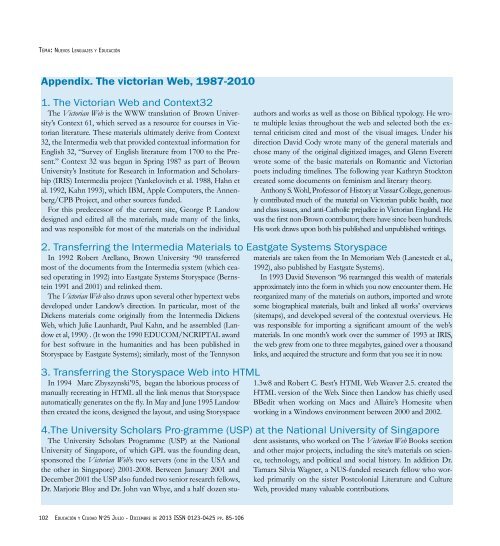Revista-Educación-y-Ciudad-No.-25
Revista-Educación-y-Ciudad-No.-25
Revista-Educación-y-Ciudad-No.-25
Create successful ePaper yourself
Turn your PDF publications into a flip-book with our unique Google optimized e-Paper software.
Tema: Nuevos Lenguajes y <strong>Educación</strong><br />
Appendix. The victorian Web, 1987-2010<br />
1. The Victorian Web and Context32<br />
The Victorian Web is the WWW translation of Brown University’s<br />
Context 61, which served as a resource for courses in Victorian<br />
literature. These materials ultimately derive from Context<br />
32, the Intermedia web that provided contextual information for<br />
English 32, “Survey of English literature from 1700 to the Present.”<br />
Context 32 was begun in Spring 1987 as part of Brown<br />
University’s Institute for Research in Information and Scholarship<br />
(IRIS) Intermedia project (Yankelovitch et al. 1988, Hahn et<br />
al. 1992, Kahn 1993), which IBM, Apple Computers, the Annenberg/CPB<br />
Project, and other sources funded.<br />
For this predecessor of the current site, George P. Landow<br />
designed and edited all the materials, made many of the links,<br />
and was responsible for most of the materials on the individual<br />
authors and works as well as those on Biblical typology. He wrote<br />
multiple lexias throughout the web and selected both the external<br />
criticism cited and most of the visual images. Under his<br />
direction David Cody wrote many of the general materials and<br />
chose many of the original digitized images, and Glenn Everett<br />
wrote some of the basic materials on Romantic and Victorian<br />
poets including timelines. The following year Kathryn Stockton<br />
created some documents on feminism and literary theory.<br />
Anthony S. Wohl, Professor of History at Vassar College, generously<br />
contributed much of the material on Victorian public health, race<br />
and class issues, and anti-Catholic prejudice in Victorian England. He<br />
was the first non-Brown contributor; there have since been hundreds.<br />
His work draws upon both his published and unpublished writings.<br />
2. Transferring the Intermedia Materials to Eastgate Systems Storyspace<br />
In 1992 Robert Arellano, Brown University ‘90 transferred<br />
most of the documents from the Intermedia system (which ceased<br />
operating in 1992) into Eastgate Systems Storyspace (Bernstein<br />
1991 and 2001) and relinked them.<br />
The Victorian Web also draws upon several other hypertext webs<br />
developed under Landow’s direction. In particular, most of the<br />
Dickens materials come originally from the Intermedia Dickens<br />
Web, which Julie Launhardt, Paul Kahn, and he assembled (Landow<br />
et al, 1990) . (It won the 1990 EDUCOM/NCRIPTAL award<br />
for best software in the humanities and has been published in<br />
Storyspace by Eastgate Systems); similarly, most of the Tennyson<br />
3. Transferring the Storyspace Web into HTML<br />
In 1994 Marc Zbyszynski’95, began the laborious process of<br />
manually recreating in HTML all the link menus that Storyspace<br />
automatically generates on the fly. In May and June 1995 Landow<br />
then created the icons, designed the layout, and using Storyspace<br />
materials are taken from the In Memoriam Web (Lanestedt et al.,<br />
1992), also published by Eastgate Systems).<br />
In 1993 David Stevenson ‘96 rearranged this wealth of materials<br />
approximately into the form in which you now encounter them. He<br />
reorganized many of the materials on authors, imported and wrote<br />
some biographical materials, built and linked all works’ overviews<br />
(sitemaps), and developed several of the contextual overviews. He<br />
was responsible for importing a significant amount of the web’s<br />
materials. In one month’s work over the summer of 1993 at IRIS,<br />
the web grew from one to three megabytes, gained over a thousand<br />
links, and acquired the structure and form that you see it in now.<br />
1.3w8 and Robert C. Best’s HTML Web Weaver 2.5. created the<br />
HTML version of the Web. Since then Landow has chiefly used<br />
BBedit when working on Macs and Allaire’s Homesite when<br />
working in a Windows environment between 2000 and 2002.<br />
4.The University Scholars Pro-gramme (USP) at the National University of Singapore<br />
The University Scholars Programme (USP) at the National<br />
University of Singapore, of which GPL was the founding dean,<br />
sponsored the Victorian Web’s two servers (one in the USA and<br />
the other in Singapore) 2001-2008. Between January 2001 and<br />
December 2001 the USP also funded two senior research fellows,<br />
Dr. Marjorie Bloy and Dr. John van Whye, and a half dozen student<br />
assistants, who worked on The Victorian Web Books section<br />
and other major projects, including the site’s materials on science,<br />
technology, and political and social history. In addition Dr.<br />
Tamara Silvia Wagner, a NUS-funded research fellow who worked<br />
primarily on the sister Postcolonial Literature and Culture<br />
Web, provided many valuable contributions.<br />
102 <strong>Educación</strong> y <strong>Ciudad</strong> N o <strong>25</strong> Julio - Diciembre de 2013 ISSN 0123-04<strong>25</strong> pp. 85-106


